WARNING: If the engine has been severely overheated, the cylinder head is likely warped.
Cleaning
Remove all traces of old gasket material and sealant from the mating surfaces of the cylinder head and intake and exhaust manifolds. Be very careful. Solvents are available from auto parts stores to soften the gasket material and make it easier to remove.
Remove dirt from coolant passages.
Scrub the various openings with a hard brush to remove sediment that may have formed in them.
Screw a suitable diameter bolt or stud into each tapped hole to remove any corrosion or sealant that may be present. If you have a compressed air source, use it to clear debris from the hole.
WARNING: Protective goggles must be worn when working with compressed air!
Clean the head bolt holes with a stiff wire brush.
Wash the cylinder head with solvent and dry thoroughly. Compressed air will speed up this process and keep all holes and openings clean.
WARNING: When cleaning, special scale removers may be helpful. These formulations are highly alkaline and should be used with great care. Read the instructions on the packaging carefully before starting work.
Clean camshaft and valve train components with solvent and dry thoroughly Do not mix them up during cleaning. Compressed air will speed up the process and keep the oil passage clean.
Clean all valve springs, seats, crackers and tappets with a solvent, dry them thoroughly. Clean one valve at a time and do not mix up their associated parts.
Remove carbon deposits that have formed on the valves with a brush.
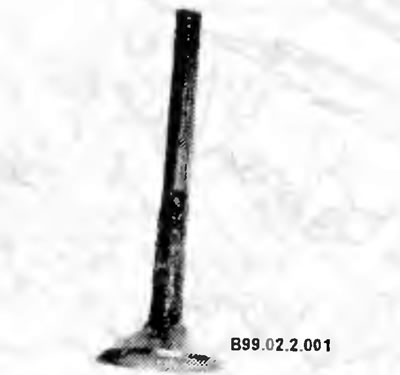
Examination
WARNING: Be sure to carry out all of the following checks before determining the need for treatment (grinding). Make a list of details that need attention.
Cylinder head
Check the head very carefully for cracks, coolant leaks, and other damage. If cracks are found, consult with specialists, repair is possible. If repair is not possible, a new cylinder head should be purchased.
Using a straight edge and a feeler gauge, check the contact surface of the head for roughness. If the roughness exceeds the limit, the surface can be sanded in the workshop.
Check the valve seats in each combustion chamber. If they have dents, cracks or burnt areas, then the saddles must be treated or replaced.
Measure the valve play in a direction perpendicular to its axis. In this case, the distance from the plate to the valve seat should be about 25 mm.
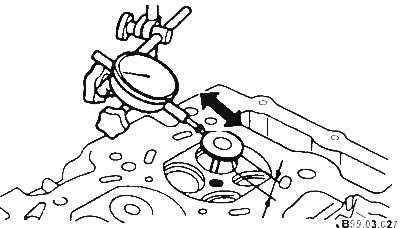
The maximum allowable backlash is 0.2 mm. If the backlash exceeds the specified limit, check the clearance between the valve and the guide sleeve by measuring the inner diameter of the sleeve and the outer diameter of the valve stem.
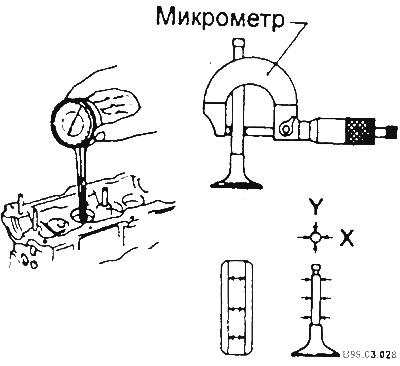
Nominal clearance for intake valves: 0.020-0.050 mm; nominal clearance for exhaust valves 0.050-0.090 mm; the maximum allowable clearance is 0.15 mm.
If the clearance exceeds the limit, replace the valve or guide sleeve.
Clean the mating surface of the cylinder head. Use a metal ruler and a feeler gauge to check if the flatness is within tolerance. Checking must be carried out in six directions, as shown in the figure below.
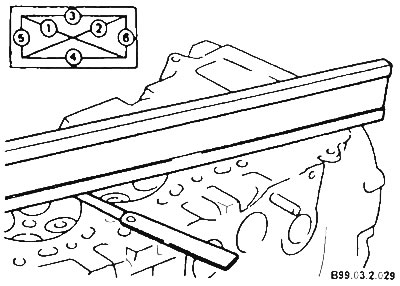
Nominal flatness deviation - no more than 0.03 mm; maximum allowable - 0.1 mm. If flatness in at least one of the directions exceeds the allowable limit, replace or regrind the cylinder head.
Valves
Carefully inspect each valve for uneven wear, deformation, cracks, dents, and burnt areas. Check the condition of the valve stem.
Rotate the valve and see if it is bent. Check for dents or heavy wear at the end of the stem. Any of the damage described indicates that the valves need to be resurfaced.
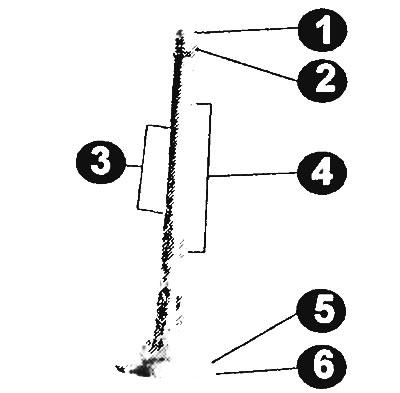
Check valve wear at specified points
1 - valve end; 2 - cracker groove; 3 - rod (least worn area); 4 - rod (most worn area); 5 - valve surface; 6 - crane.
Measure the width of the edge of each flap. If the width of the edge of the valve is less than the value specified in the technical data, then the valve must be replaced with a new one.
Valve elements
Check each valve spring at the ends for wear and dents. Measure the free length of the spring and compare the results with the control dimensions. Springs with a free length less than specified must be replaced. The tension of all springs should be measured with a special tool before deciding whether they are suitable for further use in a reconditioned engine (to carry out this check, the springs must be taken to the workshop).
Place each spring on a flat surface, check for evenness and straightness. If the springs are broken or compressed, replace all the springs in the set.
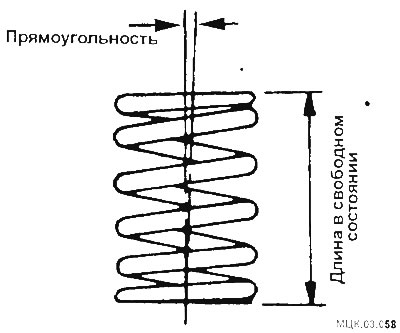
Check the spring cotters for obvious wear and cracks. All parts in doubt should be replaced with new ones, because if they fail while the engine is running, they can cause severe damage.
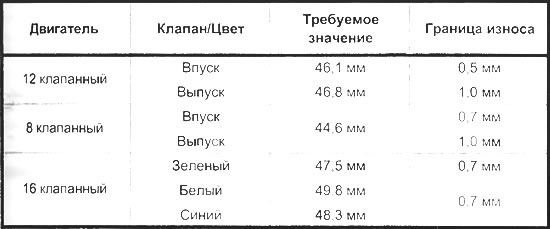
Valve lifters
ATTENTION: Hydraulic tappets must be stored in a container with oil in a vertical position.
Lower the hydraulic tappet into a container of clean diesel fuel.
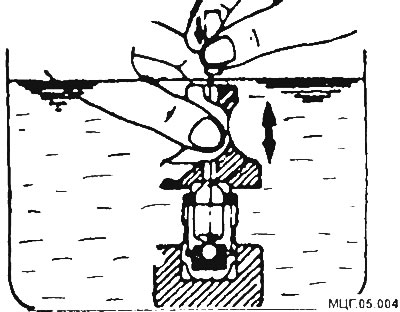
Using a special tube (for air release) press down on the steel ball and move the piston up and down a few times. The air must come out.
Remove the tube and check the condition of the hydraulic pusher - it should be in a free state. If the hydraulic pusher is compressed, then it is necessary to repeat the process of removing air.
After the air is released, install the hydraulic tappet in a special tool, check the hydraulic tappet for leakage.
If necessary, replace the hydraulic pusher with a new one.
ATTENTION: A pumped hydraulic pusher must not be laid on its side. When installing, always use the special bracket.
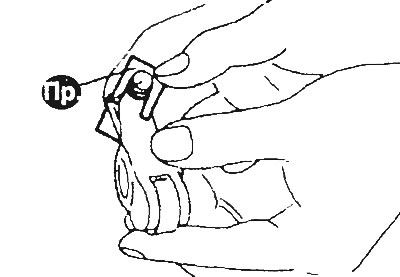
Camshaft bearing housings
Check the camshaft bearing housings for wear and damage.
If wear and cracks are found, consult with specialists. If repair is not possible, a new cylinder head should be purchased, as the camshaft bearing housings and cylinder head are machined together.
